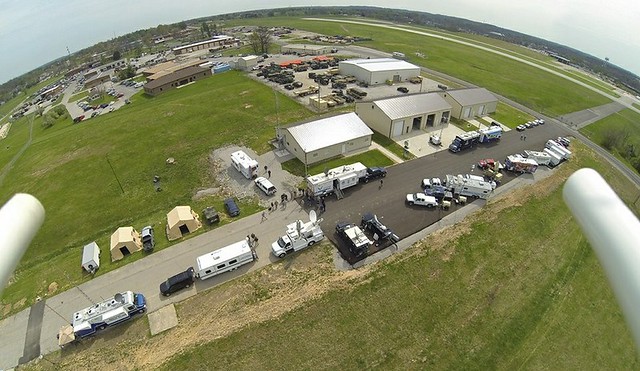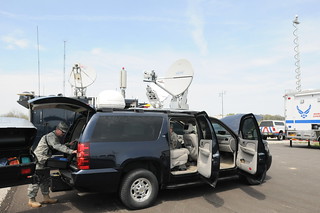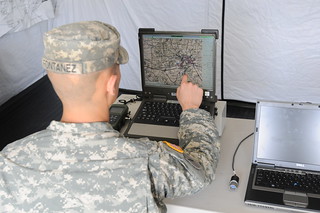Story by David Altom, Kentucky National Guard Public Affairs
[caption id="" align="alignnone" width="580"]

A bird's eye view of COMEX 2014, courtesy of a unmanned aerial vehicle. Eighteen different communications command vehicles and trailers from 11 different agencies took part in COMEX 2014, a showcase for communications capabilities for first responders held at Boone National Guard Center.
FRANKFORT, Ky. -- A recent communications exercise “showcase” held at Boone National Guard Center last April gave the Guard a chance to flex its muscles and strengthen its partnerships with local agencies.
"This showcase was developed to demonstrate interoperability with different agencies and new technologies," said Chief Warrant Officer David Barker, wireless IT manager for the Kentucky National Guard. "We had eighteen different communications command vehicles and trailers from eleven different agencies. Most if not all had some type of reach back communications capability to support data and voice without land base communications support."
In addition to National Guard and Kentucky Emergency Management assets, participating agencies included: the Kentucky Department of Transportation, the Labor Cabinet, Environmental Protection, Kentucky Early Warning System, the State Fire Marshall, and Military Auxiliary Radio Service.
Civilian volunteers, like those who run MARS, play a vital role in disaster communications. Barker was quick to champion those volunteers who took part in the showcase.
[caption id="" align="alignleft" width="320"]

A Kentucky National Guard soldier prepares to deploy some wireless communications gear during COMEX 2014. (U.S. Army National Guard photo by Staff Sgt. Scott Raymond)
“If we didn’t rely on them we’d be hurting,” he said. “In a real disaster that’s your first line of response. They love this stuff, they spend their own money on gear and they are already deployed across every region of the state, out in the field and ready to respond.
A capability that was new to the COMEX was a UAV that was able to display video locally to the participants and demonstrate how it could take quality video and pictures of a disaster scene where it was too dangerous for personnel to go.
Capt. Joe Fontanez ran the tactical end of the exercise for the COMEX. He saw the exercise as an opportunity for everyone involved.
“This year we tried to do something different and integrate our tactical communications systems in the state-wide test,” he said. “This gave participating units the opportunity to test their tactical equipment alongside civilian equipment to see what talks and what doesn't. For instance, the 63rd Theater Aviation Brigade was able to use their in house satellite communications assets for voice, video, data, and movement tracking which will enhance the incident site commander’s situational awareness on the ground.”
[caption id="" align="alignright" width="320"]

Capt. Joe Fontanez runs the tactical portion of COMEX 2014, showcasing the Kentucky National Guard's radio communications capabilities. “Our Soldiers onsite were very upbeat and excited to be working with agencies from all over the state,” he said. (U.S. Army National Guard photo by Staff Sgt. Scott Raymond)
Fontanez stressed the partnership between the agencies, specifically on what the Guard can do to help its partners in time of emergency.
“We provided satellite internet that civilian agency partners would be able to utilize on the ground and also demonstrated how our system works to pass text message traffic as well as track vehicle movement in and around the incident site.”
Doing it in a parking lot is one thing, but can they do it in the field, under real world conditions?
“We plan on getting in a long range shot (100-200 miles) next year, allowing us to demonstrate how invaluable radio communications can be in the event our online digital technology fails.”
As with every exercise, strengths are measured and weaknesses identified and corrected. All in all, COMEX 2014 brought together a wide range of capabilities and personalities,
“Our Soldiers onsite were very upbeat and excited to be working with agencies from all over the state,” said Fontanez. “Not only did they get to show off their skills and equipment, but they got the opportunity to network with similiarly minded individuals who are passionate about communications. We even helped a few people with their own equipment which gave our troops an enormous sense of pride and accomplishment.”
Barker plans on taking the COMEX to other regions of the state, which will allow the Kentucky Guard to team up with even more agencies.
“We need to branch out a capture a bigger audience,” he said. “There is a ton of emergency agencies out there that we can work with. Not everybody can come to Frankfort, so we’re going to bring the showcase to them, let them know who we are and what we can do for them when a real emergency comes up. That’s the next step.”